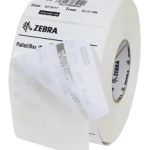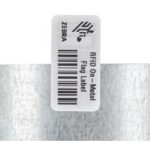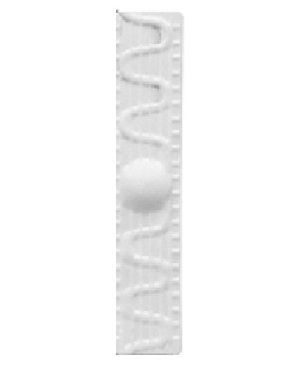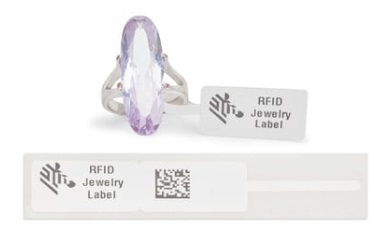RFID Labels and Tags
General Purpose RFID Labels

Works on most non-metallic
surfaces, such as plastic and corrugate. Typical applications include labeling of cases, pallets, products and healthcare specimens.
On-Metal Flag Labels

This polypropylene solution delivers strong read ranges when the antenna is touching the metal. Compatible with standard RFID printers.
Washable Linen RFID

Can be ironed on or sewn on fabric
Jewelery Labels

Polyester material with a flag design great for jewelry featuring an adhesive-free zone to eliminate residue.
RFID Labels
An RFID label is a special type of label that contains a tiny computer chip and a small antenna. RFID stands for Radio Frequency Identification, which means that these labels use radio waves to communicate information to other devices. When an RFID label is placed near a special reader device, the radio waves from the reader activate the chip in the label, allowing it to send information back to the reader. This information could include things like the product name, price, or even the location of the item.
RFID labels are often used in stores to keep track of inventory and make sure that the right products are in the right places. They can also be used in libraries to keep track of books, or in warehouses to keep track of shipments. RFID labels can be a way to allow businesses to communicate information wirelessly, which can be really helpful in a lot of different situations.
How Are Rfid Labels Different from Other Types of Labels?
RFID labels are different than other labels because they have the ability to transmit data wirelessly through radio waves. Unlike traditional labels, which can only convey information that is printed on them, RFID labels can store and transmit dynamic information that can be updated in real-time. This makes them ideal for use in inventory management, asset tracking, and other applications where real-time data is important. Additionally, RFID labels can be read without line-of-sight, meaning that they can be read through materials and from a distance, making them highly versatile and effective in a wide range of settings.
What Are the Components of an RFID Label?
RFID labels have different components. Each component in an RFID label has a specific function that allows the label to function properly.
1. Chip – This makes up an inlay along with the antenna. Microchips come with storage in the form of memory and this memory can store 3 types of information:
A. Data about the asset being tracked – This information is stored in the Electronic Power Code (EPC) memory bank. Common sizes for EPC are 96 and 128 bits but memory sizes can vary based on the microchip used
B. Data about the tag itself, such as the manufacturer.
C. Data that makes the tag work, such as access and kill passwords.
2. Antenna – This makes up an inlay along with the microchip. In essence, an antenna is what allows the RFID tag to communicate with the RFID reader. The antenna receives signals from an RFID reader and sends data back to the reader. Antennas come in many shapes and sizes with the designs being an important factor as it affects how the data is transmitted and read. Antennas are often designed for specific purposes because one size does not fit all, and different RFID applications require different sizes and shapes of the antenna. Optimal antenna design will depend on many factors, including the microchip in use, the material on which the inlay is applied, and the environment in which it will be used.
3. Inlay – Microchip connected to an antenna on a flexible substrate.
4. Carrier – The carrier of an RFID tag is what contains the inlay in whatever format is most appropriate for the application and item being tagged. Carriers can be labels or non-adhesive tags, that can vary in size and rigidity. At Zebra, we offer over 100 pre-tested materials that can be used as the carrier for your RIFD tag, providing you with many options to meet the specific requirements of your application.
Together, these components allow the RFID label to transmit information wirelessly and efficiently. If a component is missing in an RFID label, the label may not function properly or at all. For example, if the antenna is missing, the label will not be able to capture radio waves or transmit data wirelessly. Similarly, if the microchip is missing, the label will not be able to store or process data. The substrate material provides physical support and protection to the other components, so if it is missing, the antenna or microchip may be damaged or malfunction. In short, each component of an RFID label is essential for the label to function as intended, and if any component is missing, the label may not work properly.
Are RFID Labels and RFID Tags the Same?
RFID tags and RFID labels are not exactly the same, but they are often used interchangeably in many contexts.
An RFID tag typically refers to a small, electronic device that is attached to an object to identify and track it using radio waves. RFID tags can come in various shapes and sizes, and they typically consist of an antenna and a microchip that stores information about the object.
On the other hand, an RFID label refers to a label or tag that has an RFID chip and antenna embedded in it. RFID labels are often adhesive and can be easily attached to objects. They are commonly used for inventory management, asset tracking, and other applications where real-time data is important.
RFID tags can be designed to be embedded in objects, attached to surfaces, or worn by individuals. RFID labels, on the other hand, are typically designed to be attached to objects like product packaging or assets like equipment.
In short, while there are technical differences between RFID tags and labels, they are often used interchangeably in many industries to refer to devices that use radio waves to identify and track objects.
What to Consider When Choosing an RFID Label?
- Label and Inlay Size – Products that are tagged with RFID vary in size, so you need to ensure you choose a label size that fits the product. Plus, inlays need to be smaller than the label. If you need a long-read range for a product being tagged, you will need a larger inlay to provide that longer read range. But, remember, an inlay must always be smaller than the label being used.
- Surface Considerations – What surface you are trying to tag can affect what material and adhesive are used. RFID performance can vary greatly based on the type of surface you are labeling. Below are some questions you should ask when determining what kind of RFID tag to use.
- Are you tagging a rough or smooth surface?
- Will the surface be labeled wet or dry?
- What type of surface are you labeling (metal, plastic, glass, other)?
- What type of adhesive do you need?
- Mounting Method and Orientation – You need to be aware of where the RFID tag is positioned relative to the RFID reader as this can greatly affect RFID performance and read range. You need to design your RFID system with this in mind. You may also need to use something like a flag or fin to separate the inlay from the surface to improve read ranges.
- Environmental Considerations – Below are key questions you should ask when choosing what RFID tag to use.
- What temperature will the label be applied at?
- What temperature will the tag see over its life?
- How long of a lifespan with the label have?
- What sort of chemical resistance does it need?
- What kind of abrasion must the tag withstand?
- Will the tag be used once or multiple times?
- Will the label need to withstand sterilization?
- Radio Frequency Considerations – Unlike barcode labels that need a direct line of sight to be read, RFID labels do not. But certain environments can still be tricky for RFID. If you are trying to label a water bottle or a container full of liquids, the liquid actually absorbs the RF signal that is needed to be read. Because the liquid actually absorbs the RF signal, something like a flag or fin can help you get better RFID performance. Labeling metals with an RFID tag can also be very difficult because the metal actually reflects the RF signal. Zebra exclusively offers Silverline RFID labels, providing an easy solution for tough, on-metal labeling needs. Testing is always recommended when you are looking to deploy RFID in a challenging environment.
- Memory and Microchip Considerations – What information needs to be written to the microchip is always a key consideration in choosing the correct RFID tag. For standard RFID applications, a general-purpose or advanced inlay should work, but if a lot needs to be written to a chip, you may need to consider using an inlay with high user memory capabilities.
- Hardware Compatability – Of course, an RFID tag is only useful if you have the correct RFID hardware to go with it. For RFID printers, you need to consider whether a mobile, desktop, or industrial RFID printer will be in use, and choose a material based on that. For RFID readers, consider whether a handheld reader, an RFID gateway reader, or an overhead reader will be used. All the hardware plays a factor in what tag is correct for your application

